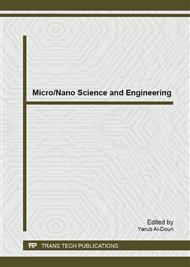[1]
B. Sabir, S. Wild, J. Bai, Metakaolin and calcined clays as pozzolans for concrete: a review, Cem Concr Compos. 23 (2001) 441-454.
DOI: 10.1016/s0958-9465(00)00092-5
Google Scholar
[2]
K. Hassan, J. Cabrera, R. Maliehe, The effect of mineral admixtures on the properties of high-performance concrete, Cem Concr Compos. 22 (2000) 267-271.
DOI: 10.1016/s0958-9465(00)00031-7
Google Scholar
[3]
R. Khatri, V. Sirivivatnanon, W. Gross, Effect of different supplementary cementitious materials on mechanical properties of high performance concrete, Cem Concr Res. 25 (1995) 209-220.
DOI: 10.1016/0008-8846(94)00128-l
Google Scholar
[4]
V. Malhotra, Role of supplementary cementing materials in reducing greenhouse gas emissions, Concrete Technology for a Sustainable Development in the 21st Century, E &FN Spon, London, (2000) 226-235.
DOI: 10.1201/9781482272215-23
Google Scholar
[5]
V. Malhotra, Fly ash, slag, silica fume, and rice-husk ash in concrete: a review, Concrete International. 15 (1993) 23-28.
DOI: 10.14359/10505
Google Scholar
[6]
P.K. Mehta, High-performance, high-volume fly ash concrete for sustainable development, Proceedings of the International Workshop on Sustainable Development and Concrete Technology, University of California, Berkeley, USA, (2004).
Google Scholar
[7]
G. Long, X. Wang,.Y. Xie, Very-high-performance concrete with ultrafine powders. Cem Concr Res. 32 (2002) 601-605.
DOI: 10.1016/s0008-8846(01)00732-3
Google Scholar
[8]
P. C. Aıtcin, The durability characteristics of high performance concrete: a review, Cem Concr Compos. 25 (2003), 409-420.
Google Scholar
[9]
C. Shi, R.L. Day, Comparison of different methods for enhancing reactivity of pozzolans. Cem Concr Res. 31 (2001) 813-818.
DOI: 10.1016/s0008-8846(01)00481-1
Google Scholar
[10]
B. Liu, Y. Xie, J. Li, Influence of steam curing on the compressive strength of concrete containing supplementary cementing materials. Cem Concr Res. 35 (2005) 994-998.
DOI: 10.1016/j.cemconres.2004.05.044
Google Scholar
[11]
S. Mindess, J. F. Young,.D. Darwin, Concrete, Prentice-Hall, (1981).
Google Scholar
[12]
I. Demir, M. Serhat Baspinar, Effect of silica fume and expanded perlite addition on the technical properties of the fly ash–lime–gypsum mixture. Const Build Mater. 22 (2008) 1299-1304.
DOI: 10.1016/j.conbuildmat.2007.01.011
Google Scholar
[13]
I. K. Cisse, M. Laquerbe, (). Mechanical characterisation of filler sandcretes with rice husk ash additions: Study applied to Senegal, Cem Concr Res. 30 (2000) 13-18.
DOI: 10.1016/s0008-8846(99)00182-9
Google Scholar
[14]
M. Laquerbe,I. Cisse, G. Ahouansou, Pour une utilisation rationnelle des graveleux latéritiques et des sables de dunes comme granulats à béton Application au cas du Sénégal, Mater Struct. 28 (1995) 604-610.
DOI: 10.1007/bf02473193
Google Scholar
[15]
A. Alhozaimy, A. AL-Negheimish, A. O. Alawad, M. S. Jaafar, J. Noorzaei, Binary and ternary effects of ground dune sand and blast furnace slag on the compressive strength of mortar, Cem Concr Compos. 34 (2012) 734-738.
DOI: 10.1016/j.cemconcomp.2012.03.002
Google Scholar
[16]
M. Alhozaimy, M. S. Jaafar, A. Al-Negheimish and J. Noorzaie, U. S. patent no. 8293006. (2012).
Google Scholar
[17]
C. A. Menzel, Strength and volume change of steam-cured portland cement mortar and concrete. In ACI Journal Proceedings. 31 (1934).
DOI: 10.14359/8337
Google Scholar


